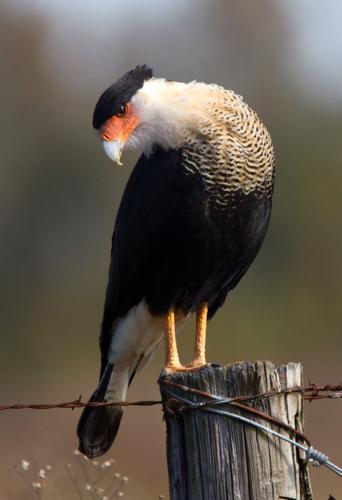Once the proud national bird of Mexico, the crested caracara, or as it was also known, the Mexican eagle, was downgraded not too long ago. This relative of the falcons is more adept at eating road kill than hunting. It’s actually not an eagle at all. And once some more research was done by the Mexican state department, it was discovered that the bird on the Mexican national seal is a golden eagle. Sorry caracara, move over. But it had a good run.
The bird on the national seal goes way back. According to Aztec legend, the sun god Huitzilopochtli asked the Tenochtitlan people to look for an eagle devouring a snake, perched on a prickly pear cactus and to build their new city on the exact spot. This was Tenochtitlan, later to become Mexico City. The problem with the bird being a caracara is that it wasn’t common there then and looks nothing like the bird on the seal. But golden eagles were and do.
The crested caracara’s range is over much of Mexico, Central America, and northern South America. In the U.S. they can be found mostly in South Texas, but also ranging up the coast and up central Texas to about Dallas. The bird once had a much larger range but, as with many birds of prey, it suffered from land use changes and the chemical DDT. It is slowly regaining footholds in previous territories, though. It can be found in smaller numbers along the upper Texas coast just past Galveston, and inland.
The crested caracara is a medium-sized blackish-brown raptor with a bit of a comical look. It has long yellow legs, and often struts along the ground. It has a flat head, with a huge down-curved bill, a big orange splotch on its face, and its head is topped with a rather shaggy black crest. When flying you will see it has long straight wings and a somewhat diamond-shaped tail. It has four “points” of white… white wing tips, white face and neck, and a white tail. The white on the head at times gets it confused with the bald eagle.
These birds mostly like fairly open habitats such as prairies, mesquite savannas, and farmlands. This describes most ranches, and so caracaras have been much maligned for killing farm animals for ages. However, their main diet consists of carrion, or already dead animals. They will hunt for small mammals and reptiles, even raid bird nests, but would much rather scavenge. They can often be seen along roads looking for roadkill, and are many times found in the company of vultures doing the same.
I don’t see them often here at the Gulf Coast Bird Observatory grounds in Lake Jackson. But I do see them often while driving around in the county. We even encounter them while on our boat doing American oystercatchers surveys, where they show up in our bays, even out on oyster reefs happily eating dead fish. Opportunistic scavenging. And while no longer the “Mexican Eagle” they should earn respect for their tenaciousness making a living in often arid areas, and cleaning up the mess!






